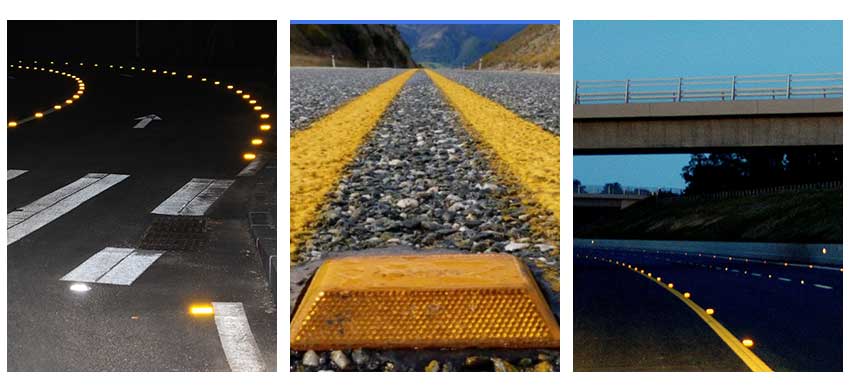As infrastructure for road traffic safety, cat’s eyes and road studs both play an important role. Their role is to help drivers identify convenience and direction at night or on roads with poor visibility. However, there are also obvious differences between cats’s eyes and road studs in terms of design, function, and application. Let’s take a look at them through this article!
1. Different definitions
The cat’s eye design originated in the UK in 1934 and is now used all over the world. The original design consisted of two pairs of reflectors embedded in a white rubber dome, which was mounted in a cast iron housing. This reflector is used to mark the center of the road, with a pair of cat’s eyes in each direction. Single-ended reflectors have been widely used on road edges and lane dividers in other colors. Cats’s eyes are particularly useful in foggy weather and are highly resistant to damage caused by snowplows.
Road studs are a safety device used on roads. These devices are usually made of plastic, ceramic, thermoplastic coatings, glass, or occasionally metal, and come in a variety of shapes and colors. Raised road studs, such as plastic, ceramic, or metal markers, including lenses or sheets, enhance visibility by reflecting car headlights, while glass road studs gather car headlights in a dome shape and reflect the light through the internal reflective layer.
2. Different materials
Cat’s eyes are usually made of glass or plastic, which are very strong and durable and can withstand vehicle crushing. Road studs can be made of a variety of materials, such as plastic, metal, ceramic, or other high-strength, pressure-resistant materials. The design of road studs is more solid, and some road studs also have LED lights.
3. Different functions
The biggest advantage of cat’s eye road studs is their all-weather focusing and reflection capabilities. Whether it is daytime or nighttime, when the vehicle lights shine on the cat’s eye road stud, it can reflect light 360 degrees, making the road boundaries and obstacles clearly visible. Especially at night or in low-light conditions, the reflective effect of cat’s eye road studs is particularly significant, which can effectively improve the driver’s vision clarity and reduce the occurrence of traffic accidents. In addition, cat’s eye road studs are not affected by the curvature of the road and can provide clearer road guidance in the turning area, improving driving safety.
Although road studs also have a certain reflective effect, their reflective range and brightness are relatively limited. Especially at night or in low-light conditions, their reflective effect may be weakened by factors such as the curvature of the road and the speed of the vehicle. Therefore, under complex road conditions, the warning effect of traditional road studs is relatively limited.
4. Different applications
Because cat’s eye road studs have the advantages of all-weather focusing and reflection capabilities and are not affected by the curvature of the road, they are widely used in high-grade roads, municipal roads, and sections where night driving safety needs to be improved. For example, in the installation of cat’s eye road studs on the Xin’ao Line of County Road X760 implemented by the Taining County Transportation Bureau, the installation of cat’s eye road studs significantly improved the night driving safety of this section of road.
Road studs are relatively low in cost and easy to install. Road studs can be installed on the center line of the road, lane dividers, roadsides, etc. In addition to reflection, they can also improve visibility through LED lights. They are sometimes used to remind drivers of narrow lanes, sharp bends, or places with special road conditions.
Although there are obvious differences between cat’s eye road studs and road studs in terms of materials, functions, and applications. However, in their application scenarios, cats’s eyes and road studs both emit bright light to mark the outline of the road and the direction of travel for drivers, providing great safety protection to ensure the driving safety of drivers.

